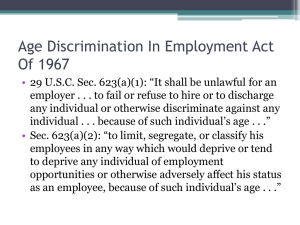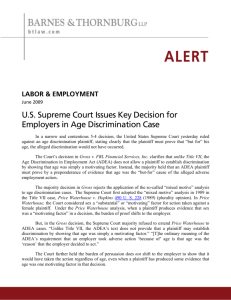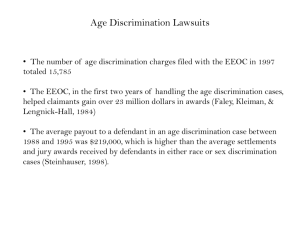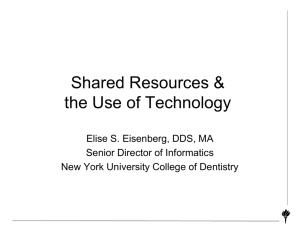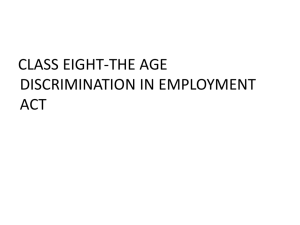U.S. Supreme Court Rules on Disparate Treatment Discrimination Claims Under ADEA
advertisement
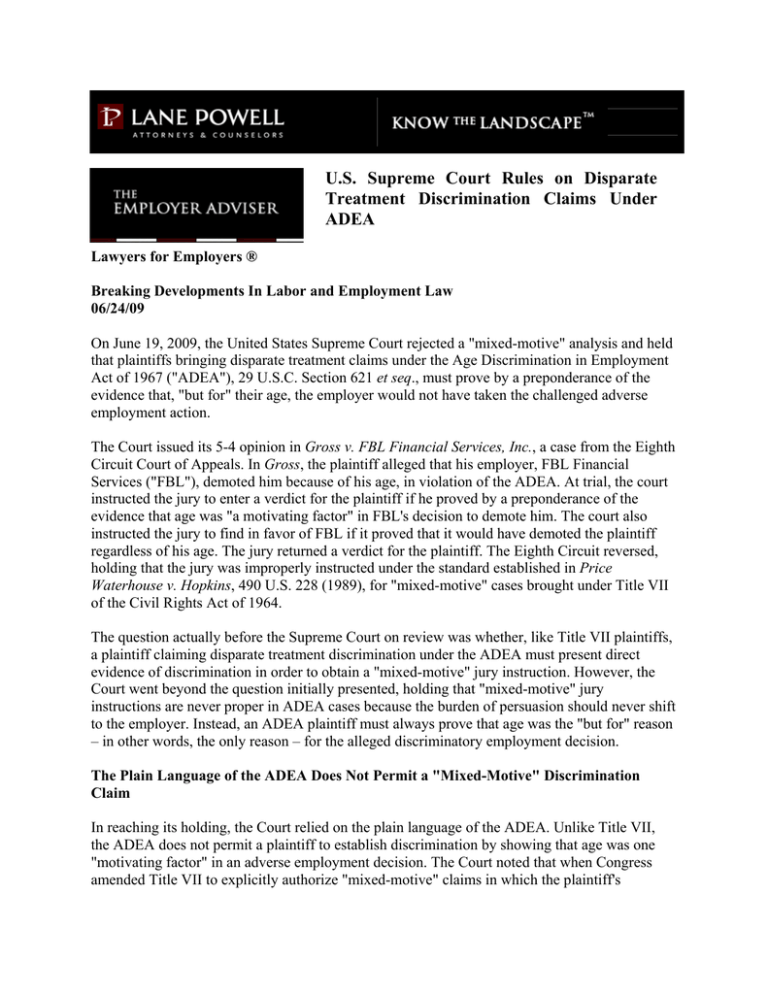
U.S. Supreme Court Rules on Disparate Treatment Discrimination Claims Under ADEA Lawyers for Employers ® Breaking Developments In Labor and Employment Law 06/24/09 On June 19, 2009, the United States Supreme Court rejected a "mixed-motive" analysis and held that plaintiffs bringing disparate treatment claims under the Age Discrimination in Employment Act of 1967 ("ADEA"), 29 U.S.C. Section 621 et seq., must prove by a preponderance of the evidence that, "but for" their age, the employer would not have taken the challenged adverse employment action. The Court issued its 5-4 opinion in Gross v. FBL Financial Services, Inc., a case from the Eighth Circuit Court of Appeals. In Gross, the plaintiff alleged that his employer, FBL Financial Services ("FBL"), demoted him because of his age, in violation of the ADEA. At trial, the court instructed the jury to enter a verdict for the plaintiff if he proved by a preponderance of the evidence that age was "a motivating factor" in FBL's decision to demote him. The court also instructed the jury to find in favor of FBL if it proved that it would have demoted the plaintiff regardless of his age. The jury returned a verdict for the plaintiff. The Eighth Circuit reversed, holding that the jury was improperly instructed under the standard established in Price Waterhouse v. Hopkins, 490 U.S. 228 (1989), for "mixed-motive" cases brought under Title VII of the Civil Rights Act of 1964. The question actually before the Supreme Court on review was whether, like Title VII plaintiffs, a plaintiff claiming disparate treatment discrimination under the ADEA must present direct evidence of discrimination in order to obtain a "mixed-motive" jury instruction. However, the Court went beyond the question initially presented, holding that "mixed-motive" jury instructions are never proper in ADEA cases because the burden of persuasion should never shift to the employer. Instead, an ADEA plaintiff must always prove that age was the "but for" reason – in other words, the only reason – for the alleged discriminatory employment decision. The Plain Language of the ADEA Does Not Permit a "Mixed-Motive" Discrimination Claim In reaching its holding, the Court relied on the plain language of the ADEA. Unlike Title VII, the ADEA does not permit a plaintiff to establish discrimination by showing that age was one "motivating factor" in an adverse employment decision. The Court noted that when Congress amended Title VII to explicitly authorize "mixed-motive" claims in which the plaintiff's protected class (e.g., race or gender) was "a motivating factor" for an adverse employment action, it contemporaneously amended the ADEA in other respects, yet did not add a similar provision permitting "mixed-motive" claims under the ADEA. Consequently, the Court reasoned that the ADEA's plain language does not authorize a "mixed-motive" age discrimination claim. The ADEA's language requires that a plaintiff prove that the alleged discriminatory action was made "because of" the plaintiff's age: "Thus, the ordinary meaning of the ADEA's requirement that an employer took adverse action 'because of' age is that age was the 'reason' that the employer decided to act." The Burden of Persuasion Always Remains With the Plaintiff The Court also held that in ADEA cases, unlike in Title VII cases, the burden of persuasion always remains with the plaintiff to prove that age was the "but for" cause of an adverse employment action. The Court noted that unless a statute contains language to the contrary, the burden of proof always rests with the plaintiff to prove "but for" causation by a preponderance of the evidence. The Court noted that the ADEA contained no exception to this rule. Accordingly – unlike in Title VII cases – the burden never shifts to the employer to show that it would have taken the same action regardless of the plaintiff's age. What This Means For Employers Although the Gross decision is favorable to employers defending ADEA disparate treatment claims, Gross was a 5-4 decision. The Court's emphasis on Congress's failure in 1991 to amend the ADEA to expressly permit mixed-motive claims, as Congress did with Title VII, leaves open the potential for Congress to disagree with the Court's result and amend the ADEA so that it mirrors Title VII's provisions expressly allowing mixed-motive discrimination claims. In any event, employers should continue to document performance and discipline concerns, without regard to age or other protected categories, for all employees, including those protected by the ADEA and other equal employment opportunity laws. Doing so will lessen the chance that an ADEA plaintiff will be able to present evidence that age was either "the" or, in the event the ADEA is amended in the future to allow mixed-motive discrimination claims, "a" reason for any adverse employment action. For more information, please contact the Labor and Employment Law Practice Group at Lane Powell: 206.223.7000 Seattle 503.778.2100 Portland 907.277.9511 Anchorage employlaw@lanepowell.com www.lanepowell.com We provide Employer Adviser as a service to our clients, colleagues and friends. It is intended to be a source of general information, not an opinion or legal advice on any specific situation, and does not create an attorney-client relationship with our readers. If you would like more 2 information regarding whether we may assist you in any particular matter, please contact one of our lawyers, using care not to provide us any confidential information until we have notified you in writing that there are no conflicts of interest and that we have agreed to represent you on the specific matter that is the subject of your inquiry. Copyright © 2009 Lane Powell PC Seattle - Portland - Anchorage - Olympia - Tacoma - London 3
